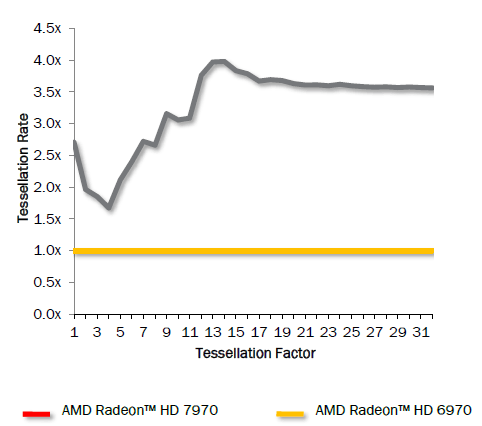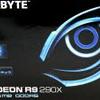PCIe Gen 3 - ZeroCore Power - Eyefinity
PCIe Gen 3
All cards in the entire AMD Radeon R7 to R9 range are PCI Express Gen 3 compatible which provides a 2x faster transfer rate than the previous generation, this delivers capabilities for next generation of extreme gaming solutions. So opposed to the current PCI Express slots which are at Gen 2, the PCI Express Gen 3 will have twice the available bandwidth and that is 32GB/s, improved efficiency and compatibility and as such it will offer better performance for current and next gen PCI Express cards. To make it even more understandable, going from PCIe Gen 2 to Gen 3 doubles the bandwidth available to the add-on cards installed, from 500MB/s per lane to 1GB/s per lane. So a Gen 3 PCI Express x16 slot is capable of offering 16GB/s (or 128Gbit/s) of bandwidth in each direction. That results in 32GB/sec bi-directional bandwidth.
You do need a PCI-E 3.0 compatible motherboard and processor though.
Power Consumption
The R9-290X have a 275 Watt TDP (maximum power draw) and that last one really is quite a bit. AMD however focused on idle states as well, when you are in desktop mode for example in the year 2008 on 55nm a graphics card would draw up-to 90 Watt. That changed dramatically on the 40nm nodes and product towards a much better ~20 Watt.
A new precedent was being set with the initial R7000 launch though as in desktop idle mode the graphics cards only consume 2.7 Watt. So when the unutilised GPU is more than 95% it can almost shut 99% of itself down, even the ventilator will spin down and disable itself (which is a little freaky when you first see it really). So what's happening there you might ask? Well, as soon as the system goes into long idle state and applications are not actively changing the screen contents, the GPU enters the ZeroCore power state. In the ZeroCore power state, the GPU core (including the 3D engine / compute units, multimedia and audio engines, displays, memory interfaces, etc.) is completely powered down. ZeroCore Power state maintains a very small bus control block to ensure that GPU content is still visible to the operating system and BIOS. The enablement of the ZeroCore Power feature is controlled by the driver. The driver on its end monitors the display contents and allows the GPU to enter the ZeroCore Power, in the condition that the GPU enters long idle and subsequent work requests are no longer being submitted to the engine. If any applications update the screen contents, ZeroCore Power technology can periodically wake the GPU to update the framebuffer contents and put the GPU back into the ZeroCore Power state. Furthermore, applications such as Windows 7/8 desktop gadgets are architected to minimize activity and save power in the long idle state. These applications are active during screen-on mode to display dynamic content such as weather, RSS feeds, stock symbols, system status, etc. but also have the intelligence to suspend any updates and activity when the system enters long idle. These applications will not wake the GPU from the ZeroCore Power state in long idle. I have immense respect for the new technology as it is a truly great achievement.
So TDP wise, the R9-290X does push up-to 275 Watt when it peaks during gaming, but 2.7 Watt in idle.
Eyefinity
One of the biggest success stories of the Radeon series was the introduction of Eyefinity. Eyefinity allows you to use multiple monitors in desktop and gaming mode. Typically you needed the very same monitors and resolutions, Eyefinity 2.0 changes that. You are able to create custom resolutions these days.
More monitor signal bandwidth is created with the Radeon HD 7000 / Radeon R7 and R9 series cards as well, you may create resolutions of 16k x 16k. This for a fact allows you to setup say five screens in 5.1 Landscape mode with 1920x1200, 2560x1600 and now even Ultra HD 4K 3840 x 2160 monitors. You guys are now starting to understand why the R9-280X has 3GB of graphics memory and the R9-290 series even 4 GB; huge resolutions require huge framebuffers. And for the above mentioned setup with 3840 x 2160 monitors that would boil down towards 11520 x 2160 pixels, that's a 24 Mpixels resolution -- HUGE. Later this year AMD catalyst drivers will support for the afore mentioned custom resolutions as well.
Improved Tessellation
The latest iteration of the architecture in the AMD Radeon GPUs features the last gen Tesselator (Gen 9) in its Geometry Engine. This features optimizations such as; increased vertex re-use, off-chip buffering improvements and larger parameter caches. This helps improve performance at all tessellation factors at up to 4x the throughput of say the AMD Radeon HD 6900 series graphics (Gen 8).

Stereo 3D - HD3D
First off let me state this, the 3D Stereo feature will get expanded to Eyefinity as well. So with the upcoming driver update you will get the option to play games in 3D on multiple monitors. But there are far more interesting news. AMD expanded on the HDMI 1.4a specification and is now going to support frame packing for Stereo 3D. And that will allow for greater framerates. The R9 series GPUs will and are the first to support 3GHz HDMI with frame packing support for Stereo 3D. See typically, you'd be limited to HDMI 1.4a restrictions. For example, the highest resolutions for 3d gaming are 720p60 or 1080p24. You couldn't do 1080p60. The new spec allows that over HDMI you can setup the screen at 1080P and get a good 60Hz per eye, thus 120Hz in total. This in the past was not possible as over HDMI you'd get 24/30 Hz (and thus FPS) per eye at 1080p. Which is great if you are a fan of seizures. For HD3D gaming you'll be reliant on an external partner like DDD for your 3D game experience though.
Direct X 11.2
All of AMD's new line-up will support DirectX 11.2 as the hardware is compatible, this also means the entire AMD R9 series will be compatible after a driver upgrade. It's a little premature to even talk about it really, DX 11.2 is to be released alongside Windows 8.1
“Today, AMD is the only GPU manufacturer to offer fully-compatible DirectX 11.1 support, and the only manufacturer to support Tiled Resources Tier-2 within a shipping product stack,” AMD said in a statement. The standout feature appears to be Direct3D tiled resources, which allows developers to easily use both GPU and system RAM to store textures. That's huge for console, not so much for high-end graphics cards though.


